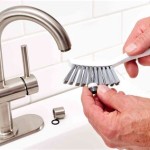How To Remove a Bathroom Ceiling Fan
Removing a bathroom ceiling fan is a task that can be undertaken by homeowners with a basic understanding of electrical work and DIY projects. However, it is crucial to prioritize safety and proceed with caution, as working with electrical components always carries inherent risks. This article provides a comprehensive guide on how to safely and effectively remove a bathroom ceiling fan, outlining the necessary tools, preparation steps, and detailed instructions for each stage of the process.
Before commencing any work, it is essential to acknowledge the potential dangers associated with electrical systems. If unsure about any aspect of the removal process, or if encountering any complications, it is strongly recommended to consult with a qualified electrician. Professional assistance ensures the job is completed safely and in compliance with local electrical codes.
This guide assumes that the existing ceiling fan is properly installed and wired. If the installation is substandard or exhibits any signs of damage, such as frayed wires or loose connections, extra care is required. It might be prudent to engage an electrician in such cases to rectify the underlying issues before proceeding with the fan removal.
Preparing for the Removal Process
Prior to touching any wires or components, meticulous preparation is paramount. This involves gathering the required tools and materials, ensuring the power supply is disconnected, and taking safety precautions to prevent electrical shock or injury.
Gathering Tools and Materials: A variety of tools are required for the safe and efficient removal of a bathroom ceiling fan. These include:
- A sturdy ladder: To safely reach the ceiling fan. Choose a ladder that is appropriate for the ceiling height and that provides a stable and secure platform to work from.
- Screwdrivers: Both Phillips head and flathead screwdrivers of various sizes are needed to remove the screws holding the fan components together.
- Wire strippers: To safely strip the insulation from electrical wires when disconnecting them.
- Wire connectors (wire nuts): To properly insulate and connect the wires after the fan isremoved. These ensure a secure and safe connection.
- Electrical tape: To further insulate wire connections and provide an extra layer of protection.
- Voltage tester (non-contact): To verify that the power to the circuit is completely off before working with the wires. This is a crucial safety measure.
- Pliers: For gripping and manipulating wires.
- Gloves (insulated): To protect hands from electrical shock and cuts.
- Safety glasses: To protect eyes from debris.
- Headlamp or flashlight: To provide sufficient light in the work area. Bathroom lighting is often inadequate for detailed electrical work.
- Trash bag or container: To dispose of removed parts and materials.
Disconnecting the Power Supply: Disconnecting the power supply to the bathroom ceiling fan circuit is the single most important step in the entire removal process. Failure to do so can result in severe electrical shock or electrocution. Locate the circuit breaker that controls the bathroom ceiling fan. This is typically found in the electrical panel (breaker box). Once located, switch the breaker to the "OFF" position. To ensure that the power is completely off, use a non-contact voltage tester to verify that there is no voltage present at the fan's wiring connections. Test each wire individually to confirm the absence of current. If the voltage tester indicates the presence of voltage, double-check that the correct breaker has been switched off, and re-test. If the problem persists, consult with an electrician before proceeding.
Safety Precautions: In addition to disconnecting the power supply, other safety precautions are essential. Wear insulated gloves and safety glasses to protect hands and eyes. Inform other household members that electrical work is being performed in the bathroom and that they should not tamper with the circuit breaker or any electrical devices in the area. Consider placing a warning sign on the electrical panel indicating that work is in progress. This helps prevent accidental reactivation of the circuit. Ensure the work area is well-lit and free from obstructions. A clear and organized work space reduces the risk of accidents.
Removing the Fan Components
Once the power is safely disconnected and the work area is prepared, proceed with the removal of the fan components. This typically involves disassembling the fan housing, disconnecting the wiring, and removing the mounting bracket.
Disassembling the Fan Housing: Most bathroom ceiling fans have a light fixture and a fan housing that are attached to a mounting bracket. Start by removing the light fixture cover or globe, if present. This is usually held in place by screws or clips. Carefully detach the cover and set it aside. Next, disconnect the light bulb. After removing the light fixture components, focus on the fan housing. This is typically attached to the mounting bracket with screws. Use the appropriate screwdriver to remove these screws. Support the fan housing with one hand while removing the screws to prevent it from falling. Once all the screws are removed, carefully lower the fan housing. It may be necessary to gently wiggle or pry the housing to loosen it from the bracket.
Disconnecting the Wiring: With the fan housing lowered, the electrical wiring connections will be accessible. Before disconnecting any wires, take pictures or make a detailed diagram of the wiring configuration. This will be helpful if a new fan or light fixture is being installed. Typically, there will be three wires: a black (hot) wire, a white (neutral) wire, and a green or bare copper (ground) wire. The wires are usually connected to the house wiring using wire connectors (wire nuts). Carefully unscrew the wire connectors to disconnect each wire. As each wire is disconnected, use electrical tape to insulate the exposed end. This prevents accidental contact with any other wires or conductive surfaces. Once all the wires are disconnected and insulated, set the fan housing aside.
Removing the Mounting Bracket: The final step in the removal process is to remove the mounting bracket from the ceiling. The mounting bracket is typically attached to the ceiling joist or a support structure with screws. Use the appropriate screwdriver to remove these screws. Support the mounting bracket with one hand while removing the screws to prevent it from falling. Once all the screws are removed, carefully remove the mounting bracket. Inspect the ceiling box where the mounting bracket was attached. Ensure that the box is securely fastened to the ceiling joist and that there are no signs of damage or deterioration. If the box is damaged, it may need to be replaced before installing a new fan or light fixture.
Securing Exposed Wiring
After removing the ceiling fan and its mounting bracket, the electrical wiring within the ceiling box remains exposed. It is crucial to properly secure these wires to prevent accidental contact and ensure safety. This involves insulating the individual wires and securing them within the ceiling box.
Insulating the Wires: Each individual wire (black, white, and green/bare copper) must be properly insulated to prevent accidental contact and potential electrical shock. Ensure that each wire end is covered with electrical tape. Wrap the tape securely around the exposed wire, overlapping the insulation slightly to provide a complete seal. This prevents any exposed conductor from coming into contact with other wires or metallic surfaces.
Securing Wires Within the Ceiling Box: After insulating each wire, carefully tuck the wires back into the ceiling box. The ceiling box is designed to protect the wiring connections and prevent them from being exposed to the surrounding environment. Ensure that the wires are not twisted or tangled within the box. Position the wires so that they are neatly arranged and take up as little space as possible. If the ceiling box has a cover plate, secure the cover plate over the opening to further protect the wiring. This provides an additional layer of safety and prevents dust, debris, or other foreign objects from entering the box.
Alternatives for Unused Wiring: If there is no intention of installing a new fan or light fixture in the immediate future, consider capping off the wires with wire connectors (wire nuts) in addition to the electrical tape. Wire connectors provide a secure and insulated connection that is more robust than electrical tape alone. Place the wire connectors over the ends of the insulated wires and twist them tightly to ensure a secure connection. After installing the wire connectors, secure the cover plate over the ceiling box. If the ceiling box does not have a cover plate, consider purchasing one from a hardware store. A cover plate provides a finished look and prevents the entry of dust and debris. Another option is to completely remove the wiring back to the nearest junction box, but this requires a more advanced understanding of electrical wiring and should only be performed by a qualified electrician.
By following these detailed instructions and prioritizing safety, homeowners can successfully remove a bathroom ceiling fan. However, it is imperative to remember that electrical work involves inherent risks. If there are any doubts or uncertainties, seeking professional assistance is always the safest option.

Not Sure How To Remove Old Bathroom Fan Install New One Doityourself Com Community Forums

How To Remove Clean Bathroom Ceiling Fan Nutone

Remove Install A Bathroom Fan Grille In 1 Min

How To Replace A Bathroom Exhaust Fan Stanley Tools

How To Replace A Bathroom Exhaust Fan Without Attic Access 12 Step Guide Home Inspector Secrets

Comment Remplacer Un Ventilateur De Salle Bain

How To Remove And Install Bathroom Exhaust Fan

Tips For Installing Or Replacing A Bathroom Fan Forbes Home

How To Replace A Bathroom Fan Motor Quick Diy Approach

Help Can T Remove Old Bathroom Exhaust Fan Housing Doityourself Com Community Forums
Related Posts







